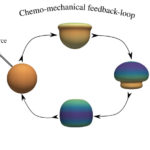News, Designing Soft Materials that Mimic Biological Functions
Northwestern Engineering researchers have developed a theoretical model to design soft materials that demonstrate autonomous oscillating properties that mimic biological functions. The work could advance the design of responsive materials used to deliver therapeutics as well as for robot-like soft materials that operate autonomously. The design and synthesis of materials with biological functions require a delicate balance between structural form and physiological function. During embryonic development, for instance, flat sheets of embryonic cells morph through a series of folds into intricate three-dimensional structures such as branches, tubes, and furrows. These, in turn, become dynamic, three-dimensional building blocks for organs performing vital functions like heartbeat, nutrient absorption, or information processing by the nervous system.
Learn about our two Decals!
 Click here to find out more about our Fall Bioinspired Design Decal and our Spring Bioinspired Design in Action Decal – ALL MAJORS are welcome.
Click here to find out more about our Fall Bioinspired Design Decal and our Spring Bioinspired Design in Action Decal – ALL MAJORS are welcome.Berkeley BioDesign Community
 Click here to learn about the BioD: Bio-Inspired Design @ Berkeley student organization or here to signup for more info.
Click here to learn about the BioD: Bio-Inspired Design @ Berkeley student organization or here to signup for more info.Search
Student Login




I imagine that the neurological circuits underlying these processes are governed by both 2d spacing maps with their brains as…
to reduce the impact of car accidents, it may be possible to study the force diverting physics of cockroaches to…
you see this type of head-bobbing stability in many avian creatures related to pigeons like chickens. the head ability to…
not like they taught horses how to run! this is an example of convergent evolution where both sea creatures and…
The brain functions in a similar way with neuronal connections. our brains are able to utilize the multiplicity of connections…